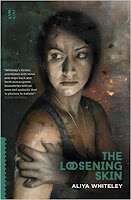Semiosis is, like Aliya Whiteley's The Loosening Skin, one of six contenders for the 2019 Clarke Award, to be announced this Wednesday. I'd hate to have to make the call between the two books (let alone the others) because Semiosis is excellent.
It charts the early history of an Earth colony on alien world over five generations and 107 years. Chapters are mostly told from the perspective of one colonist and then we jump a generation and learn, in passing, how that person died.
The first human settlers name the planet "Pax", and each chapter opens with a quote from their constitution, an effort to set out how they will go forward as Pacifists. Characters, too, discuss their efforts to meet the standards set by the original settlers:
That life includes Stevland, a sentient plant who even narrates some of the story, runs for political office and converses with duplicituous orange trees. Stevland is ambitious and powerful, modifying the fruit it grows and the humans consume so they'll better serve its purpose. Unsurprisingly, some of the humans find this sinister and want to limit Stevland's reach - but the colony is also dependent on that very food.
The humans are also not the only non-native species: there's evidence of creatures the humans name Glassmakers. Again, we're not quite sure what to make of them or their intentions until very late in the story - and individuals don't all agree. The humans, too, are well drawn and distinct, conflicting personalities. A big part of the power of the book is how much we feel the loss of even people we've only met briefly.
I must admit I got to the end of the first, 33-page chapter feeling I'd seen this kind of new-colony stuff before, but Semiosis is something special. The title means signs - the production of meaning others are meant to understand. It's a treatise on how we communicate with others. Unlike so much of colony-in-space fiction, it's not about conquest or the triumph of will and science. The constant thread through the generations is negotiation, of speaking to your enemies to compromise and find peace. It's not always possible - there are terrible mistakes, and there is terrible malice. But the aspiration holds, and leaves the reader with hope.
It charts the early history of an Earth colony on alien world over five generations and 107 years. Chapters are mostly told from the perspective of one colonist and then we jump a generation and learn, in passing, how that person died.
The first human settlers name the planet "Pax", and each chapter opens with a quote from their constitution, an effort to set out how they will go forward as Pacifists. Characters, too, discuss their efforts to meet the standards set by the original settlers:
"Only intelligent creatures also create civilization. Civilization creates the idea of peace as well as war, and makes both possible. I am a Pacifist. I have chosen the idea that I intend to make real." (p. 248).For all the ideals, it's rarely very easy. There are accidents, sickness and worse. Some of it is pretty hard going - I'm especially susceptible to stuff about the death of a baby, and there's a battle towards the end that is as horrifying as it is compelling, characters ruthlessly despatched. One section is about the hunt for a serial killer. And yet on the whole this is, I think, a fantasy of integration, of making a success of weaving humanity into the strange fabric of another world that teems with strange and hostile life.
That life includes Stevland, a sentient plant who even narrates some of the story, runs for political office and converses with duplicituous orange trees. Stevland is ambitious and powerful, modifying the fruit it grows and the humans consume so they'll better serve its purpose. Unsurprisingly, some of the humans find this sinister and want to limit Stevland's reach - but the colony is also dependent on that very food.
The humans are also not the only non-native species: there's evidence of creatures the humans name Glassmakers. Again, we're not quite sure what to make of them or their intentions until very late in the story - and individuals don't all agree. The humans, too, are well drawn and distinct, conflicting personalities. A big part of the power of the book is how much we feel the loss of even people we've only met briefly.
I must admit I got to the end of the first, 33-page chapter feeling I'd seen this kind of new-colony stuff before, but Semiosis is something special. The title means signs - the production of meaning others are meant to understand. It's a treatise on how we communicate with others. Unlike so much of colony-in-space fiction, it's not about conquest or the triumph of will and science. The constant thread through the generations is negotiation, of speaking to your enemies to compromise and find peace. It's not always possible - there are terrible mistakes, and there is terrible malice. But the aspiration holds, and leaves the reader with hope.














































